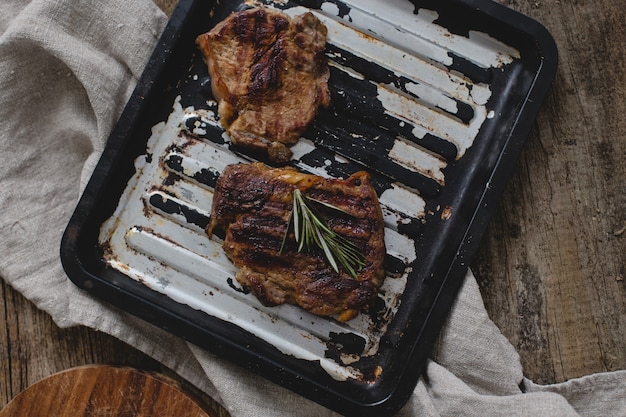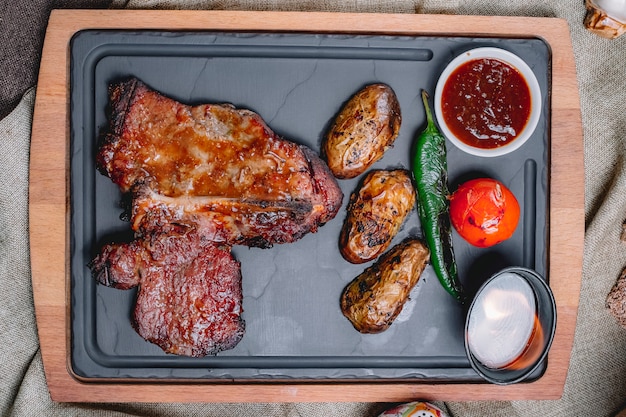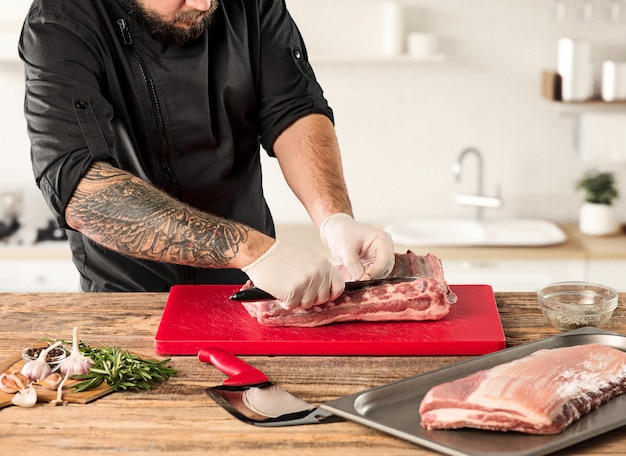(Part 1) Choosing Your Ribs: The Foundation of Flavor

Baby back ribs vs. spare ribs: A Battle of the Bones
Now, the two main contenders are baby back ribs and spare ribs. They're both good, but they have their own unique personalities.Baby backs are the more popular choice. They're leaner, have a more tender texture, and are generally easier to cook. You know, the ones you see on all those fancy menus. But they're also a bit pricier, and there's less meat to go around.
Spare ribs, on the other hand, are bigger, meatier, and usually a bit more affordable. They've got a nice bit of fat on them, which adds flavor and helps keep them moist during cooking. But they can be a bit tougher, and they require a bit more patience to cook properly.
My personal preference? Honestly, it depends on the occasion. For a special occasion, I'll go for the baby backs. But for a casual weeknight meal, I'll happily settle for a rack of spare ribs.
Here's a handy table to help you decide:
| Baby Back Ribs | Spare Ribs | |
|---|---|---|
| Meatiness | Leaner, less meat | Meatier, more fat |
| Tenderness | More tender | Can be tougher |
| cooking time | Shorter | Longer |
| Price | More expensive | More affordable |
Other Cuts: Don't Be Afraid to Branch Out
Don't be afraid to explore other cuts of ribs, either. You might come across beef ribs, lamb ribs, or even pork belly ribs. They're all worth trying, offering a different flavor experience altogether.I recently had a go at cooking some beef short ribs, and let me tell you, they were absolutely divine. They're a bit richer and more decadent than pork ribs, with a melt-in-your-mouth texture that's just heavenly. They require a bit longer cooking time, but the result is truly worth it.
(Part 2) The Art of the Rub: Creating Your Own Flavor Symphony

Essentials for a Winning Rub
Think of a rub as a spice blend, but specifically for your ribs. A good rub will have a mix of sweet, salty, and savory flavors, with a touch of heat if you like it hot. The key is to balance these flavors to create a symphony of taste.- Salt: The most basic, but crucial for drawing out moisture and enhancing flavor. Use a good quality kosher salt for best results.
- Pepper: Adds a bit of heat and depth. Black pepper is a classic, but feel free to experiment with white pepper or even a pinch of cayenne.
- Sugar: Provides sweetness and helps caramelize the ribs during cooking. Brown sugar is a common choice, but you can also use honey, maple syrup, or even molasses.
- Smoked Paprika: Gives those smoky undertones that everyone loves. Look for Hungarian paprika for a deeper, richer flavor.
- Garlic Powder: Adds a punch of flavor and aroma. Freshly ground garlic is even better, if you have the time.
- Onion Powder: Another great way to bring those savory flavors to the party. Freshly chopped onions, caramelized in a pan, will add a more complex flavor profile.
- Other Spices: Don't be afraid to get adventurous with other spices. Chili powder, cumin, oregano, thyme, and rosemary can all add delicious layers of flavor to your rub.
My Go-To rib rub Recipe: A Simple, Delicious Start
Here's a simple rub recipe I always start with: 2 tablespoons smoked paprika 2 tablespoons brown sugar 1 tablespoon garlic powder 1 tablespoon onion powder 1 tablespoon salt 1 tablespoon black pepperMix it all together, rub it all over the ribs, and then let it work its magic for at least an hour or two. You can even let it sit in the fridge overnight for maximum flavor infusion.Remember, this is just a starting point. Feel free to experiment with different spices and herbs to create your own signature rub.
Tips for Rubbing Ribs Like a Pro
Apply evenly: Make sure to rub the spice blend evenly over all surfaces of the ribs, ensuring every part gets a good coating. Pat it in: Don't just sprinkle the rub on; gently pat it into the meat to help it adhere and penetrate the fibers. Let it rest: Give the rub time to work its magic. At least an hour, preferably longer, will allow the flavors to meld and permeate the ribs.(Part 3) Mastering the Art of Smoking: The Key to Tenderness and Flavor

Getting Started: Your Smoker Setup
First things first, you'll need a smoker. There are tons of options out there, from simple charcoal smokers to fancy pellet grills.I've used both, and honestly, it really comes down to personal preference. Charcoal smokers give you more control over the heat and smoke, while pellet grills are super convenient and provide consistent results.
Here's a breakdown of the pros and cons of each type:
- Charcoal Smokers:
- Pros: More control over heat and smoke, authentic barbecue flavor, generally more affordable
- Cons: Can be more time-consuming, requires more attention, can be messy
- Pellet Grills:
- Pros: Easy to use, consistent results, wide temperature range, often have digital controls
- Cons: Can be more expensive, limited in terms of smoke flavor, may not be as versatile as charcoal smokers
Setting the Stage: The Smoking Process
Once you've got your smoker ready, it's time to start the smoking process.I usually aim for a temperature between 225°F and 250°F. You'll need to use wood chips for that smoky flavor.
I always soak my wood chips in water for about 30 minutes before adding them to the smoker. This helps them smolder rather than burst into flames, creating a consistent and even smoke.
Choosing the Right Wood
The type of wood you use will also influence the flavor of your ribs. Here are some popular choices:- Hickory: Strong, smoky flavor, classic barbecue choice
- Mesquite: Bold, earthy flavor, can be overwhelming if used too much
- Oak: Mild, nutty flavor, good for all-around use
- Apple: Sweet, fruity flavor, good for ribs with a glaze
- Cherry: Sweet, slightly tart flavor, good for ribs with a glaze
The Smoking Symphony: Patience is Key
Okay, so the ribs are in the smoker, the wood chips are smoldering, and the temperature is just right. Now, the most important ingredient: patience.smoking ribs takes time. It's not a quick meal. I usually smoke my ribs for 4 to 6 hours, until they're tender and fall off the bone.
The beauty of smoking is that you can walk away and let the magic happen. Keep an eye on the temperature, but don't obsess over it. Relax, have a beer, and enjoy the process.
Tips for Smoking Ribs Like a Pro
Maintain consistent temperature: Keep a close eye on the smoker temperature and adjust the vents as needed to maintain a steady heat. Add wood chips throughout: Add more soaked wood chips every hour or so to maintain a good smoke flow. Don't overcook: Keep an eye on the ribs and don't overcook them. Overcooked ribs will be dry and tough.(Part 4) The Glaze Game: Adding the Final Touches of Flavor
Alright, your ribs are smoky, tender, and almost ready to devour. Now, it's time to add that final layer of flavor – the glaze.Glazing Essentials: A Sweet and Savory Symphony
A good glaze should have a balance of sweet, savory, and tangy flavors. Here are some basic ingredients you can use: Sweetness: Brown sugar, honey, maple syrup, molasses, or even ketchup. Savory: Worcestershire sauce, soy sauce, or even a splash of vinegar. Tangy: Mustard, apple cider vinegar, or lemon juice. Other Flavors: Get creative and add some extra zing with ingredients like chipotle powder, cayenne pepper, garlic powder, onion powder, or even a hint of ginger.Simple Glaze Recipes: Get Creative!
Here are a couple of simple glaze recipes you can try:Classic BBQ Glaze:
- 1 cup ketchup
- 1/2 cup brown sugar
- 1/4 cup apple cider vinegar
- 2 tablespoons Worcestershire sauce
- 1 teaspoon mustard
- 1/2 cup honey
- 1/4 cup Dijon mustard
- 2 tablespoons soy sauce
- 1 tablespoon apple cider vinegar
The Art of Glazing: A Brushstroke of Flavor
Once you've got your glaze ready, it's time to glaze those ribs. I usually glaze them for the last hour of smoking, but you can glaze them earlier if you like.Just use a brush to apply a thin layer of glaze to the ribs. Make sure to get every nook and cranny!
Then, let the ribs continue to cook, allowing the glaze to caramelize and create that beautiful, glossy finish.
Tips for Glazing Ribs Like a Pro:
Don't overdo it: A thin layer of glaze is all you need. Too much glaze can make the ribs soggy. Glaze frequently: Glaze the ribs every 30 minutes or so during the last hour of cooking to ensure an even coating and a beautiful caramelized finish. Keep an eye on it: Keep a close watch on the glaze as it cooks, as it can burn easily. If it starts to get too dark, lower the heat or remove the ribs from the smoker.(Part 5) The Wrap-Up: Bringing It All Together
Alright, the ribs are done. They're smoky, tender, and glazed to perfection. Now, it's time to wrap them up and let them rest.The Importance of Resting: A Time for Tenderness
Resting the ribs is crucial for allowing the juices to redistribute throughout the meat. This will make them even more tender and juicy.I usually wrap the ribs in aluminum foil for 30 minutes to an hour, allowing them to rest.
It's tempting to dig in right away, but trust me, those ribs will thank you later.
(Part 6) Serving Up Perfection: The Grand Finale
The moment you've been waiting for has arrived. It's time to serve those ribs!The Side Show: Creating the Perfect Accompaniments
No rib feast is complete without a fantastic lineup of sides.Think creamy coleslaw, tangy potato salad, or some fluffy cornbread. You can't go wrong with classic sides that complement those delicious ribs.
I love serving my ribs with a side of baked beans and a simple green salad. It's a perfect balance of flavors and textures.
Here are some other side dish ideas:
- Macaroni and cheese
- corn on the cob
- grilled vegetables
- fruit salad
- Potato wedges
The Presentation: Making it a Showstopper
Now, let's talk about presentation. It's not just about the food; it's about the experience.You can serve your ribs on a beautiful platter, with a generous helping of your favorite sides.
I like to garnish my ribs with some fresh parsley or cilantro for a pop of color and flavor.
A drizzle of glaze on top is always a good idea, too.
(Part 7) Ribs Beyond the Barbecue: Expanding Your Horizons
Okay, we've covered the basics of smoking and grilling ribs, but there's a whole world of rib cooking out there!The oven method: A Convenient Alternative
If you don't have a smoker, don't worry! You can still achieve delicious ribs in the oven.Simply rub your ribs with your favorite spice blend, wrap them in foil, and bake them in a preheated oven at 300°F for 2-3 hours, or until they're tender.
You can then unwrap the ribs, baste them with your glaze, and bake them for another 30 minutes or so, until the glaze is caramelized.
Other Techniques: Get Creative in the Kitchen
Don't be afraid to experiment with other techniques, either.You can braise ribs in a slow cooker for a super tender and flavorful result.
You can even try roasting ribs in a dutch oven for a rustic and comforting meal.
Here's a quick guide to other rib cooking methods:
- Slow Cooker: Perfect for tenderizing tougher cuts of ribs, resulting in melt-in-your-mouth texture.
- Dutch Oven: Great for roasting ribs, creating a crispy exterior and a juicy, flavorful interior.
- instant pot: Quick and convenient for cooking ribs, especially if you're short on time.
(Part 8) Ribs Around the World: Global Flavor Inspirations
You'd be surprised by how many different cultures have their own unique takes on ribs.korean bbq ribs: A Sweet and Savory Delight
Korean BBQ ribs are known for their sweet and savory flavors, with a touch of heat.They're typically marinated in a blend of soy sauce, garlic, ginger, sugar, and gochujang (Korean chili paste).
Then, they're grilled to perfection and served with a variety of side dishes, like kimchi and rice.
Chinese Ribs: A Fusion of Flavors
Chinese ribs are all about a combination of sweet, salty, and savory flavors.They're often marinated in a blend of soy sauce, oyster sauce, hoisin sauce, and sugar.
Then, they're braised or roasted until tender and served with steamed rice and stir-fried vegetables.
Mexican Ribs: A Burst of Spicy Flavor
Mexican ribs are known for their fiery flavors and tender texture.They're typically marinated in a blend of chili powder, cumin, paprika, and oregano.
Then, they're grilled or roasted and served with tortillas, salsa, and other Mexican sides.
Here's a table showcasing some global rib variations:
| Region | Flavor Profile | Typical Ingredients | Cooking Method |
|---|---|---|---|
| Korean | Sweet, savory, spicy | Soy sauce, garlic, ginger, sugar, gochujang | Grilled |
| Chinese | Sweet, salty, savory | Soy sauce, oyster sauce, hoisin sauce, sugar | Braised or roasted |
| Mexican | Spicy, savory | Chili powder, cumin, paprika, oregano | Grilled or roasted |
| Caribbean | Sweet, spicy, tangy | Jerk seasoning, brown sugar, Scotch bonnet peppers | Grilled or smoked |
| American BBQ | Smoky, sweet, savory | Brown sugar, paprika, garlic powder, onion powder, salt, pepper | Smoked or grilled |
(Part 9) FAQs: Your Rib-Related Questions Answered
Okay, let's tackle those burning rib questions!1. How do I know when my ribs are done?
Your ribs are done when they're tender and fall off the bone. You can check for tenderness by poking them with a fork. If the meat gives way easily, they're ready. You can also use a meat thermometer to ensure the internal temperature reaches 145°F for pork ribs.2. Can I freeze ribs?
Yes, you can freeze ribs. Wrap them tightly in plastic wrap and then aluminum foil. They'll stay good in the freezer for up to 3 months. Just thaw them in the refrigerator overnight before cooking.3. What if my ribs are too dry?
If your ribs are too dry, you can try adding a bit of moisture to them. You can wrap them in foil with a little bit of broth or apple juice, or you can simply baste them with a glaze more frequently.4. How do I make ribs more flavorful?
You can make your ribs more flavorful by using a flavorful rub, smoking them with wood chips, or glazing them with a delicious sauce.Don't be afraid to experiment with different flavors and find what you like best.
5. What's the best way to reheat ribs?
The best way to reheat ribs is to wrap them in aluminum foil and bake them in a preheated oven at 300°F for 30 minutes, or until they're heated through.You can also reheat them on the grill or in a slow cooker.
Just make sure they're heated through before serving.
(Part 10) The Final Word: A Rib-tastic Journey
There you have it, folks. Your complete guide to tender, flavor-packed ribs.I hope you've enjoyed this journey as much as I have.
Remember, the key to perfect ribs is patience, creativity, and a willingness to experiment.
So, fire up your smoker, get creative with your rubs and glazes, and get ready to enjoy some of the most delicious ribs you've ever tasted.
Happy ribbing!
Everyone is watching

How to Cook Frozen Lobster Tails Perfectly: A Step-by-Step Guide
RecipesLobster. Just the word conjures up images of lavish meals, special occasions, and a taste of luxury. But let's...

Pork Fillet Cooking Time: How Long to Cook It Perfectly
RecipesPork fillet, or tenderloin as it's sometimes called, is a real favourite in our house. It's so versatile, and...

Pigs in a Blanket Cooking Time: How Long to Bake for Perfect Results
RecipesAh, pigs in a blanket. Just the name conjures up images of those delightful little parcels of crispy pastry en...

The Ultimate Guide to Cooking Delicious Frankfurters
RecipesLet's face it, we all love a good frankfurter. It's a classic, simple, and always satisfying. But let's be rea...

Wolf Meat Recipes: A Guide to Cooking Wild Game
RecipesLet's be honest, you don't see wolf meat at your local butcher shop every day. It's a bit of a wild card, but ...
